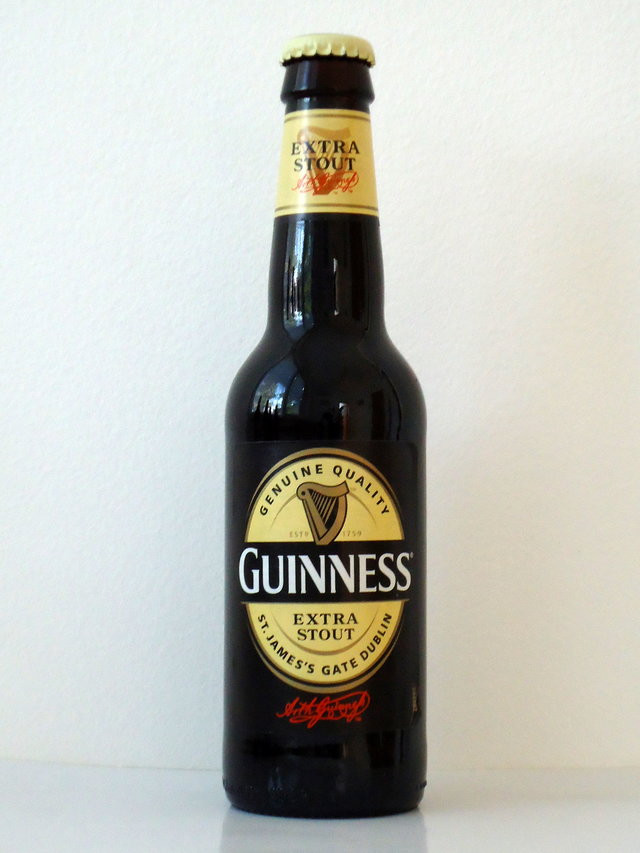It's St. Patrick's Day, and you know what that means -- you're going to
get a Guinness.
And so is that dude right next to you, even though neither of you is
Irish. Drinking Guinness Stout is an Irish tradition that's as prolific
as dressing up in green and imploring people to kiss you, but not many
people know the deeper history of this magical elixir. For example, did
you know that the original Guinness Brewery belongs to the Guinness
family for the next 8,745yrs?
So stick with us, and you'll learn some truly eye-opening stuff about Guinness, just in time to get it all over yourself.
Kevin Alexander
1. Their famous dry stout is (officially) a very dark ruby color, rather than black
This is due to the roasting of malted barley, a process which the
brewery compares to making coffee. The other ingredients in the beer are
water, hops, brewer's yeast, and malt extract. That's it.
Wikipedia
2. Guinness Brewery was founded in 1759 by Arthur Guinness, a guy who had 21 children
Yeah. This dude was prolific both in beer and in progeny, and was
affectionately nicknamed "Uncle Arthur" by the people of Dublin -- a
moniker that got extended to his beer. That's right: you can ask for a
pint of Uncle Arthur, and people to this day will serve you a Guinness.
It remains the most popular alcoholic drink in all of Ireland even
today, and that's saying something.
3. The St. James's Gate Brewery was leased to the Guinness family for 9,000 years
Arthur, obviously anticipating that his company's stout beer would be
wildly popular, took out an unprecedented 9,000yr lease on the St.
James's Gate Brewery in Dublin for £45 per year. It's now the world's
largest stout brewer, and that bank is really hitting itself for giving
it out so cheaply.
4. Guinness is brewed in more than 60 countries and available in over 100
Annually, the world drinks around 1.8bill pints of the stuff. That's
1,800,000,000 pints. Enough for everyone in the world to have a quarter
of a pint -- although some people probably wouldn't be willing to share.
5. Guinness was the world's seventh-largest company in the 1930s
Before this, production steadily increased through the early 1900s until
1914, when a landmark was reached: the brewery was producing roughly
2,000,000 barrels of beer per year, which was more than double its
nearest competitor (Bass), and accounted for 10% of the UK's beer
market. Talk about kicking Bass!
6. Guinness's distinctive creamy head is due to the presence of nitrogen
The element that makes up most of Earth's atmosphere is also the one
that makes Guinness so damn delicious. The chemical formula of Guinness
is low in carbon dioxide (making for a smoother, less effervescent
texture) and relatively high in nitrogen, which is less soluble than CO2
and makes for a less acidic taste.
Yeah, we just talked to Bill Nye about beer. What up?
7. The Guinness Harp wasn't introduced to the logo until 1862
It was added by noted harp-enthusiast Benjamin Lee Guinness, who based
it off of the Trinity College Harp, which in turn dates back to the 14th
or 15th century and is one of the few remaining medieval Gaelic harps.
It also faces right, instead of the left-facing harp on the Irish coat
of arms -- y'know, to shake things up.
8. The brewery's famous toucan wasn't even a part of its brand until the 1940s
As part of a zoo-themed advertising campaign (logical, since Guinness is
best enjoyed at zoos), artist John Gilroy drew up a bunch of print
spots that included poems and bold statements (e.g. "Guinness Makes You
Strong") accompanied by toucans, lions, seals, ostriches, and kangaroos.
They would later go on to become almost synonymous with the beer
itself.
9. In addition to its Stout, Guinness also makes an Extra Stout -- and has discontinued a bunch of other beers
Some of the brews you should pour one out for are: Guinness Cream Stout,
Guinness Pilsner, Guinness Shandy, Guinness Brite Lager, Guinness XXX
Extra Strong Stout, and a citrusy wheat beer called Guinness Breó,
meaning "glow" -- which cost around 5 million Irish pounds to make.
10. Guinness is good for you, dude!
There are studies out there claiming that the antioxidants present in
Guinness are beneficial to the heart, in that they make it harder for
cholesterol to accumulate in the arteries. Also, Guinness has fewer
calories than skim milk, orange juice, or pretty much any other
non-light beer out there. For your health!
11. The Guinness Storehouse in Dublin is a seven-story shrine to the stout
Located adjacent to the brewery, the Guinness Storehouse is a museum,
archive, and showroom of all of Guinness's history, brewing process, and
products, and it houses a copy of the 9,000yr lease we mentioned
earlier. Even Queen Elizabeth II has been there, so it's way more than a
tourist trap.
12. More than 13 million pints of Guinness are consumed on St. Patrick's Day ALONE
That's more than double the normal daily average, and most of said St.
Patrick's Day drinking takes place in the United States, often by people
who aren't even really Irish! But when you've got a pint of Guinness in
your hands, you really can't help but feel like you are.
Adam Lapetina is a food/drink staff writer at Thrillist, and couldn't possibly be more/less Irish. Read his musings on Twitter at @adamlapetina.
 26977
26977








No comments:
Post a Comment
Please leave a comment-- or suggestions, particularly of topics and places you'd like to see covered